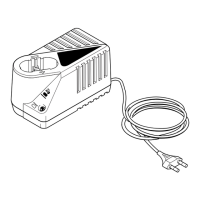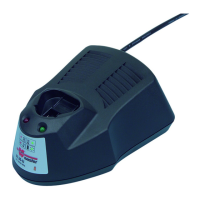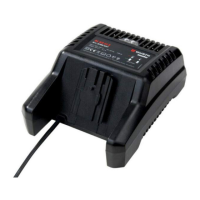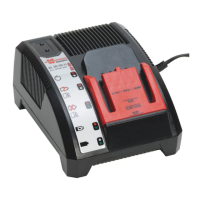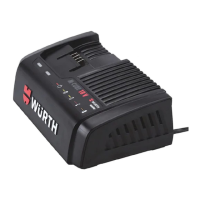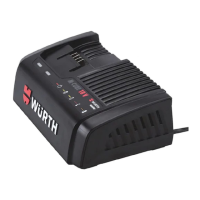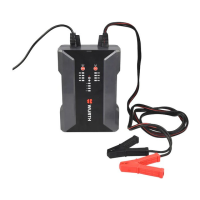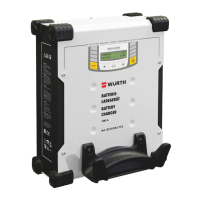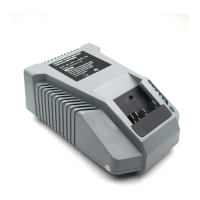Do you have a question about the Würth Acctiva Easy Basic 1206 and is the answer not in the manual?
Manual contains important safety and operating instructions for the battery charger.
Instructions on selecting and using extension cords safely, including minimum AWG size.
Guidelines on operating the charger safely, including avoiding damage and disassembly.
Warning about explosive gases generated by lead-acid batteries during operation.
Safety precautions to take when working near a lead-acid battery.
Steps and precautions for preparing to charge a battery.
Guidelines for positioning the charger away from the battery and ensuring ventilation.
Instructions for connecting and disconnecting DC output clips safely.
Arrange cords to prevent damage from vehicle parts and maintain clearance.
How to identify positive/negative posts and the grounded battery post.
Steps for connecting charger clips to negative or positive grounded vehicles.
Steps for safely disconnecting the charger from the vehicle.
Check battery polarity and attach ground cable to the negative post.
Connecting the positive charger clip to the battery and negative clip to cable.
Disconnecting the charger in the reverse order of connection.
Specific instructions for charging marine batteries on shore.
Safety warning regarding use by children and infirm persons requiring supervision.
Indicates a potentially dangerous situation where death or serious injury may result.
Indicates a situation where minor injury or property damage could occur.
Indicates a risk of flawed results or possible equipment damage.
Provides tips for correct operation and useful information.
Charger manufactured to safety standards; misuse can cause injury or damage.
Requirements for personnel involved with the charger's operation and maintenance.
Operating instructions should be accessible during use.
Safety notices on the charger must be kept legible and intact.
Address any safety-compromising faults before operating the charger.
Use the charger only for its intended purpose as described.
Intended use includes reading instructions, performing service, and following manufacturer guidelines.
Operating or storing the charger outside stipulated areas is misuse.
Refer to technical data for permitted environmental conditions.
Risks include electrocution and hazardous electromagnetic fields.
Ensure cables and leads are in good condition; repair damaged ones.
Batteries contain harmful acid and release explosive gases during charging.
Keep ignition sources away from the battery due to explosive gases.
Do not disconnect battery connections during charging.
Ensure the charging area is well ventilated and avoid inhaling gases.
Prevent short circuits by keeping tools and metal objects off the battery.
Protect eyes and skin from battery acid; rinse spills with water.
Protect batteries from dirt and mechanical damage, store in cool place.
Perform weekly visual checks of battery acid levels.
Actions to take if battery exhibits faults like uneven acid levels or overheating.
Keep people, especially children, away from the charger during operation.
Ensure the work area is safe before leaving it unattended.
Operate chargers with PE conductors only on grounded mains supply.
Operate the charger according to its IP rating.
Do not operate a damaged charger.
Maintain unobstructed airflow through the charger's vents.
Regularly check the mains and charger supply grounding.
Repair or replace faulty safety devices before operating.
Do not bypass or disable safety protection devices.
Ensure the mains plug is easily accessible after installation.
The charger requires minimal maintenance for normal operation.
Check mains plug, cable, and terminals for damage before use.
Clean the charger housing with a soft cloth and mild cleaner.
Maintenance and repair should only be performed by authorized personnel.
Do not modify the device without manufacturer consent.
Dispose of the device according to national and local regulations.
Operators must prevent electromagnetic interference from the charger.
Information on EMC device classification (Class A vs. Class B).
User is responsible for factory setting changes; manufacturer is not liable for lost settings.
Warranty provided according to legal/country-specific regulations.
Damage from normal wear, overload, or misuse is not covered by the guarantee.
Warranty claims require the charger to be handed over intact to an authorized service center.
Do not dispose of the device with household waste; follow EU directive.
Comply with EU directive for separate collection and recycling of electrical equipment.
Declaration of conformity with safety standards and directives.
Copyright of operating instructions belongs to the manufacturer.
Welcome message and introduction to the manual for familiarization.
Explains the controls and connection points of the charger.
Warning about incorrect selector switch settings causing damage or poor results.
Guide to setting the selector switch based on battery type and voltage.
Important note prohibiting the charging of dry batteries (primary cell).
Consequences of incorrect selector switch settings.
Warning about explosion risk from short circuits and arcs during connection/disconnection.
Step-by-step instructions for connecting the charger to the battery.
Instructions for safe disconnection to avoid short circuits and arcs.
Specific information about the on-board plug feature for Acctiva Easy.
Information about vehicle on-board socket variations; consult manufacturer.
Importance of connecting the charger directly to the battery for best results.
Do not connect to mains during testing; charger draws power from the battery.
Warning about hazards from rotating vehicle parts in the engine compartment.
Automatic test phases run after connecting to the battery.
Test results are for information only and should be seen as recommendations.
Procedure for measuring the battery's open circuit voltage.
Procedure for testing the battery's startability.
Charger checks alternator voltage while the engine is running.
Steps to finish the generator test and begin charging.
Warning about explosion risks and checking connections during charging.
Caution regarding charging a faulty battery; ensure it is functional.
Steps to initiate the battery charging process.
Automatic transition to conservation charging once the battery is fully charged.
Charger charges deep-discharge batteries with gentle pulses over a long period.
Conditions for reconnecting a deep-discharged battery to the vehicle.
Consumer loads can be used during trickle charging, with considerations.
Charger powers car electronics during battery changes to retain settings.
Critical warning about short-circuiting during back-up mode operations.
Common faults and their remedies, such as incorrect pole connection.
Troubleshooting issues encountered during test mode operations.
Troubleshooting common errors that occur during the charging process.
Explanation of the safety cut-out feature and its activation conditions.
Steps to take when the charger's safety cut-out is activated.
Identifies causes like battery size, accessory power, battery faults, or incorrect settings.
Information regarding wall mounting of the Acctiva Easy charger.
Explanation of symbols found on the charger's rating plate.
Detailed technical specifications for the Acctiva Easy 1206 model.
Manual contains important safety and operating instructions for the battery charger.
Instructions on selecting and using extension cords safely, including minimum AWG size.
Guidelines on operating the charger safely, including avoiding damage and disassembly.
Warning about explosive gases generated by lead-acid batteries during operation.
Safety precautions to take when working near a lead-acid battery.
Steps and precautions for preparing to charge a battery.
Guidelines for positioning the charger away from the battery and ensuring ventilation.
Instructions for connecting and disconnecting DC output clips safely.
Arrange cords to prevent damage from vehicle parts and maintain clearance.
How to identify positive/negative posts and the grounded battery post.
Steps for connecting charger clips to negative or positive grounded vehicles.
Steps for safely disconnecting the charger from the vehicle.
Check battery polarity and attach ground cable to the negative post.
Connecting the positive charger clip to the battery and negative clip to cable.
Disconnecting the charger in the reverse order of connection.
Specific instructions for charging marine batteries on shore.
Safety warning regarding use by children and infirm persons requiring supervision.
Indicates a potentially dangerous situation where death or serious injury may result.
Indicates a situation where minor injury or property damage could occur.
Indicates a risk of flawed results or possible equipment damage.
Provides tips for correct operation and useful information.
Charger manufactured to safety standards; misuse can cause injury or damage.
Requirements for personnel involved with the charger's operation and maintenance.
Operating instructions should be accessible during use.
Safety notices on the charger must be kept legible and intact.
Address any safety-compromising faults before operating the charger.
Use the charger only for its intended purpose as described.
Intended use includes reading instructions, performing service, and following manufacturer guidelines.
Operating or storing the charger outside stipulated areas is misuse.
Refer to technical data for permitted environmental conditions.
Risks include electrocution and hazardous electromagnetic fields.
Ensure cables and leads are in good condition; repair damaged ones.
Batteries contain harmful acid and release explosive gases during charging.
Keep ignition sources away from the battery due to explosive gases.
Do not disconnect battery connections during charging.
Ensure the charging area is well ventilated and avoid inhaling gases.
Prevent short circuits by keeping tools and metal objects off the battery.
Protect eyes and skin from battery acid; rinse spills with water.
Protect batteries from dirt and mechanical damage, store in cool place.
Perform weekly visual checks of battery acid levels.
Actions to take if battery exhibits faults like uneven acid levels or overheating.
Keep people, especially children, away from the charger during operation.
Ensure the work area is safe before leaving it unattended.
Operate chargers with PE conductors only on grounded mains supply.
Operate the charger according to its IP rating.
Do not operate a damaged charger.
Maintain unobstructed airflow through the charger's vents.
Regularly check the mains and charger supply grounding.
Repair or replace faulty safety devices before operating.
Do not bypass or disable safety protection devices.
Ensure the mains plug is easily accessible after installation.
The charger requires minimal maintenance for normal operation.
Check mains plug, cable, and terminals for damage before use.
Clean the charger housing with a soft cloth and mild cleaner.
Maintenance and repair should only be performed by authorized personnel.
Do not modify the device without manufacturer consent.
Dispose of the device according to national and local regulations.
Operators must prevent electromagnetic interference from the charger.
Information on EMC device classification (Class A vs. Class B).
User is responsible for factory setting changes; manufacturer is not liable for lost settings.
Warranty provided according to legal/country-specific regulations.
Damage from normal wear, overload, or misuse is not covered by the guarantee.
Warranty claims require the charger to be handed over intact to an authorized service center.
Do not dispose of the device with household waste; follow EU directive.
Comply with EU directive for separate collection and recycling of electrical equipment.
Declaration of conformity with safety standards and directives.
Copyright of operating instructions belongs to the manufacturer.
Welcome message and introduction to the manual for familiarization.
Explains the controls and connection points of the charger.
Warning about incorrect selector switch settings causing damage or poor results.
Guide to setting the selector switch based on battery type and voltage.
Important note prohibiting the charging of dry batteries (primary cell).
Consequences of incorrect selector switch settings.
Warning about explosion risk from short circuits and arcs during connection/disconnection.
Step-by-step instructions for connecting the charger to the battery.
Instructions for safe disconnection to avoid short circuits and arcs.
Specific information about the on-board plug feature for Acctiva Easy.
Information about vehicle on-board socket variations; consult manufacturer.
Importance of connecting the charger directly to the battery for best results.
Do not connect to mains during testing; charger draws power from the battery.
Warning about hazards from rotating vehicle parts in the engine compartment.
Automatic test phases run after connecting to the battery.
Test results are for information only and should be seen as recommendations.
Procedure for measuring the battery's open circuit voltage.
Procedure for testing the battery's startability.
Charger checks alternator voltage while the engine is running.
Steps to finish the generator test and begin charging.
Warning about explosion risks and checking connections during charging.
Caution regarding charging a faulty battery; ensure it is functional.
Steps to initiate the battery charging process.
Automatic transition to conservation charging once the battery is fully charged.
Charger charges deep-discharge batteries with gentle pulses over a long period.
Conditions for reconnecting a deep-discharged battery to the vehicle.
Consumer loads can be used during trickle charging, with considerations.
Charger powers car electronics during battery changes to retain settings.
Critical warning about short-circuiting during back-up mode operations.
Common faults and their remedies, such as incorrect pole connection.
Troubleshooting issues encountered during test mode operations.
Troubleshooting common errors that occur during the charging process.
Explanation of the safety cut-out feature and its activation conditions.
Steps to take when the charger's safety cut-out is activated.
Identifies causes like battery size, accessory power, battery faults, or incorrect settings.
Information regarding wall mounting of the Acctiva Easy charger.
Explanation of symbols found on the charger's rating plate.
Detailed technical specifications for the Acctiva Easy 1206 model.
| Brand | Würth |
|---|---|
| Model | Acctiva Easy Basic 1206 |
| Category | Battery Charger |
| Language | English |
